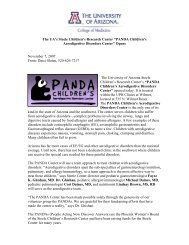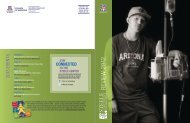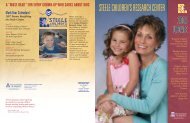Read More - the Steele Children's Research Center - University of ...
Read More - the Steele Children's Research Center - University of ...
Read More - the Steele Children's Research Center - University of ...
Create successful ePaper yourself
Turn your PDF publications into a flip-book with our unique Google optimized e-Paper software.
Tee Up For Tots Courtney Page Zillman Fellow 2007:<br />
Collin J. LaCasse<br />
Exploring <strong>the</strong> Causes <strong>of</strong> Necrotizing Enterocolitis<br />
Congratulations to<br />
Collin J. LaCasse, who has<br />
been named <strong>the</strong> 2007 Tee<br />
Up For Tots Courtney Page<br />
Zillman Fellow.<br />
Collin began his<br />
PhD studies in <strong>the</strong><br />
UA Department <strong>of</strong><br />
Immunobiology in 2006,<br />
and joined <strong>the</strong> lab <strong>of</strong><br />
Emmanuel Katsanis, MD.<br />
His research interests<br />
include understanding immune responses to cancer and<br />
controlling that immune response to treat pediatric cancers.<br />
Dr. Katsanis’ laboratory has developed a novel cancer vaccine,<br />
CRCL (Chaperone Rich Cell Lysate), which soon will enter clinical<br />
trials. However, <strong>the</strong> efficacy <strong>of</strong> all cancer vaccines is limited by<br />
<strong>the</strong> cancer cells’ ability to suppress <strong>the</strong> immune system. Cancer<br />
does this by initiating recruitment and proliferation <strong>of</strong> immune<br />
regulatory cells. These cells dampen anti-tumor immunity in<br />
<strong>the</strong> tumor microenvironment. Collin is working with researchers<br />
Dr. Katasanis and Nicolas Larmonier, PhD, to explore ways to<br />
suppress <strong>the</strong> activity <strong>of</strong> <strong>the</strong>se regulatory cells and <strong>the</strong>refore<br />
allow for greater anti-tumor immunity. To do this <strong>the</strong>y are<br />
investigating a variety <strong>of</strong> drugs that may specifically inhibit <strong>the</strong><br />
action <strong>of</strong> regulatory cells. The success <strong>of</strong> this approach should<br />
drastically impact <strong>the</strong> success <strong>of</strong> cancer vaccine treatments.<br />
Collin attended Lafayette College in Easton, Penn. While<br />
at Lafayette, Collin was a member <strong>of</strong> <strong>the</strong> Phi Kappa Psi<br />
fraternity, International Student Association, <strong>the</strong> Catholic<br />
Newman Association and <strong>the</strong> (South Asian) Tsunami Relief<br />
Committee. As a member <strong>of</strong> <strong>the</strong>se groups he twice held <strong>the</strong><br />
<strong>of</strong>fice <strong>of</strong> philanthropy committee chairman and fostered<br />
numerous community service collaborations among each <strong>of</strong> <strong>the</strong>se<br />
organizations. Collin’s research interest in cancer immunology<br />
was sparked during this period while doing two years <strong>of</strong><br />
independent research under Robert Kurt, MD in <strong>the</strong> Department<br />
<strong>of</strong> Biology.<br />
“ Thank You ” from Collin LaCasse<br />
Whe<strong>the</strong>r raising funds, supporting a loved one, working in<br />
<strong>the</strong> clinic or innovating in <strong>the</strong> lab, we are all doing what we can<br />
to make a difference in <strong>the</strong> fight against cancer. This is no small<br />
feat for any <strong>of</strong> us. Making a difference against cancer is difficult<br />
wea<strong>the</strong>r you choose <strong>the</strong> fight against cancer or cancer chooses<br />
<strong>the</strong> fight against you. Shortly after being named <strong>the</strong> Courtney<br />
Page Zillman Fellow, I sent Mr. Zillman an e-mail. I told Mr.<br />
Zillman that even before I knew who Courtney was, I found her<br />
picture on <strong>the</strong> wall <strong>of</strong> one <strong>of</strong> <strong>Steele</strong> <strong>Center</strong>’s research hallways<br />
inspiring.<br />
Working toward a PhD in immunology and cancer biology is<br />
not easy. Courtney reminded me that as taxing as cancer research<br />
can be, my battle against cancer in <strong>the</strong> lab is absolutely nothing<br />
next to <strong>the</strong> battles that Courtney and countless o<strong>the</strong>r children<br />
battling cancer have fought. Those <strong>of</strong> us who have been blessed<br />
with <strong>the</strong> ability to fight cancer on our own terms should always<br />
be thankful <strong>of</strong> this fact. This is why every day I go to work, my<br />
goal is to win this fight in <strong>the</strong> lab so that all children can have<br />
an illness-free childhood like I had. Because <strong>of</strong> help from Tee<br />
Up For Tots, our lab is in a position to help bring forth a new<br />
era where cancer<br />
will someday be a<br />
thing <strong>of</strong> <strong>the</strong> past.<br />
Cancer<br />
research is<br />
expensive and <strong>the</strong><br />
decreasing amount<br />
<strong>of</strong> federal funding<br />
has made securing<br />
research dollars<br />
harder than in any<br />
o<strong>the</strong>r time in recent memory. Our laboratory is better <strong>of</strong>f than<br />
most because <strong>of</strong> <strong>the</strong> strong leadership, innovation and expertise<br />
<strong>of</strong> Dr. Katsanis and Dr. Larmonier. However, even our lab has felt<br />
this pinch in federal funds. This is where Tee Up For Tots has<br />
helped us maintain our momentum at a time when many o<strong>the</strong>r<br />
labs have had to scale back <strong>the</strong>ir research.<br />
Tee Up For Tots funding has supplied us with much <strong>of</strong> <strong>the</strong><br />
materials and equipment we need for continued progress in <strong>the</strong><br />
lab. Their generosity has contributed greatly to our lab’s novel<br />
cancer vaccine, CRCL which will be entering clinical trials in<br />
<strong>the</strong> coming months. The Courtney Page Zillman Fellowship, in<br />
addition to making <strong>the</strong> research that I do possible, has opened<br />
up funding for o<strong>the</strong>r promising researchers whose continued<br />
efforts have been indispensable.<br />
I am truly thankful for this opportunity as <strong>the</strong> Courtney Page<br />
Zillman Fellow. I can’t wait for <strong>the</strong> day when our findings in <strong>the</strong><br />
lab and <strong>the</strong> implementation <strong>of</strong> those findings in <strong>the</strong> clinic will<br />
contribute to <strong>the</strong> eradication <strong>of</strong> pediatric cancers. Tee Up For<br />
Tots has helped us immensely to help make this day come a little<br />
sooner.<br />
Every year, more than half a million babies in <strong>the</strong> U.S. are<br />
born prematurely. That’s about 12.5 percent <strong>of</strong> all births. Babies<br />
born prematurely (before 37 weeks) face a host <strong>of</strong> serious health<br />
problems. Many <strong>of</strong> <strong>the</strong>se potential health risks are well known<br />
and understood, including mental retardation, cerebral palsy,<br />
lung and gastrointestinal problems, vision and hearing loss.<br />
Ano<strong>the</strong>r less-known disease that threatens premature babies<br />
is Necrotizing Enterocolitis (NEC)—a painful inflammatory<br />
gastrointestinal disorder. Every year, approximately 9,000<br />
premature infants are diagnosed with NEC in <strong>the</strong> U.S., and<br />
20-50 percent won’t survive. And <strong>the</strong>se numbers are increasing<br />
annually.<br />
<strong>Steele</strong> <strong>Center</strong> <strong>Research</strong> Assistant Pr<strong>of</strong>essor Melissa Halpern,<br />
PhD, recently was awarded a five-year grant from <strong>the</strong> National<br />
Institutes <strong>of</strong> Health (NIH) to investigate <strong>the</strong> mechanisms<br />
involved in <strong>the</strong> development <strong>of</strong> NEC. Dr. Halpern’s interest in<br />
this disease isn’t just pr<strong>of</strong>essional; it’s personal, too. Her son,<br />
Ryan—born 8 weeks prematurely—developed NEC when he was<br />
4 weeks old. “We were lucky,” says Dr. Halpern. “Ryan’s NEC<br />
wasn’t severe enough to require surgery. But this was a wake-up<br />
call to a disease that is fairly common among preemies, but not<br />
well known or understood.” This personal experience pr<strong>of</strong>oundly<br />
influenced Dr. Halpern, and she changed her research focus to<br />
NEC.<br />
The exact cause <strong>of</strong> NEC is unknown, and <strong>the</strong>re are no specific<br />
treatments for this devastating disease. In severe cases, a child’s<br />
inflamed intestines may tear or perforate, allowing bacteria to<br />
leak into <strong>the</strong> abdomen, potentially causing a life-threatening<br />
systemic infection. Damaged intestines may require surgery to<br />
remove <strong>the</strong> infected areas. And, unfortunately, many children<br />
who have surgical intervention must face lifelong digestive<br />
difficulties. New research also has shown a higher rate <strong>of</strong><br />
learning disabilities in children that developed NEC as newborns.<br />
Using a neonatal rat model <strong>of</strong> NEC, Dr. Halpern and her team<br />
were <strong>the</strong> first to show that elevated levels <strong>of</strong> intestinal bile acids<br />
contribute to disease development. Building upon <strong>the</strong>ir past<br />
research, her laboratory now is focused on understanding why<br />
bile acids accumulate in <strong>the</strong> intestine causing <strong>the</strong> damage that<br />
leads to NEC.<br />
For a variety <strong>of</strong> reasons, babies born prematurely usually are<br />
fed formula instead <strong>of</strong> breast milk. The essential fats in formula<br />
are different than those in breast milk and require more bile<br />
acids to break down <strong>the</strong> fats for digestion. Normally, <strong>the</strong> liver<br />
produces bile acids and sends <strong>the</strong>m to <strong>the</strong> intestines to do <strong>the</strong>ir<br />
job <strong>of</strong> breaking down <strong>the</strong> fats. Transporter systems move <strong>the</strong> bile<br />
acids into <strong>the</strong> intestinal cells to complete <strong>the</strong> digestion process.<br />
Next, ano<strong>the</strong>r transporter<br />
system removes <strong>the</strong> bile<br />
acids from <strong>the</strong> cells and<br />
takes <strong>the</strong>m back to <strong>the</strong> liver,<br />
where <strong>the</strong> liver determines if<br />
more bile acids are needed<br />
for digestion.<br />
With NEC, however, this doesn’t happen. Dr. Halpern and her<br />
team hypo<strong>the</strong>size that <strong>the</strong>re is a malfunction with <strong>the</strong> transport<br />
system responsible for exporting <strong>the</strong> bile acids from <strong>the</strong> cells<br />
back to <strong>the</strong> liver. “Essentially, we believe that <strong>the</strong> transporter<br />
mechanisms fail to adequately remove <strong>the</strong> bile acids from <strong>the</strong><br />
intestinal cells. Because little bile is re-circulated back to <strong>the</strong><br />
Dr. Halpern and her son, Ryan.<br />
liver, <strong>the</strong> liver continues to send more bile acids to <strong>the</strong> intestine.<br />
Consequently, bile continues to accumulate, causing damage<br />
to <strong>the</strong> intestines—leading to NEC,” Dr. Halpern explains. “Our<br />
grant is exploring <strong>the</strong> reasons why <strong>the</strong> transport mechanisms are<br />
faulty.”<br />
“If <strong>the</strong>se hypo<strong>the</strong>ses are verified through our research, we<br />
may be able to use elevated levels <strong>of</strong> bile acids in premature<br />
infants’ intestines to predict which babies are at risk <strong>of</strong><br />
developing NEC. Once identified, we can intervene before<br />
irreparable damage to <strong>the</strong> intestine occurs,” explains Dr. Halpern.<br />
8 9







